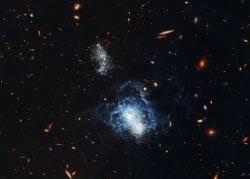Look at the picture associated with this story. It just looks like a pretty galaxy, right? Well, according to astronomers, it’s actually much older than it appears. This image, captured by the Hubble Space Telescope, provides one of the most detailed observations ever taken of I Zwicky 18 – a galaxy that looks younger than it should.
According to researcher, galaxies like I Zwicky 18 are much more common billions of light years away, at a time when the Universe was much younger than it is today. These baby galaxies still had large quantities of gas and dust they could use up to make new stars. Their young hot stars, composed largely of primordial hydrogen and helium manufactured during the Big Bang, burn brightly in the blue end of the visible light spectrum.
Older galaxies, like our own Milky Way have had plenty of time to use up those primordial elements, mixing in heavier elements with generation after generation of supernovae.
Astronomers used to think that I Zwicky 18 was a rare example of a nearby, newly forming galaxy. Located only 59 million light-years from Earth, this galaxy could be used as a sort of time machine, to see the stages that galaxies went through early on in their evolution.
Well, the new observations from Hubble have dashed those hopes. I Zwicky 18 is old, possibly as old as the Milky Way, forming its first stars up to 10 billion years ago. With its sensitive instruments, Hubble was able to spot previously hidden red, older stars, showing that the galaxy has been forming stars for billions of years.
So how is it possible that such an old galaxy still has large quantities of primordial hydrogen and helium, but we see rapid star formation today? It’s possible that the galaxy has just been going slowly, forming stars at a dramatically reduced rate in the past. But something kicked that rate of star formation into high gear in the recent past.
Original Source: Hubble News Release

